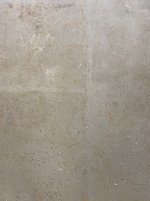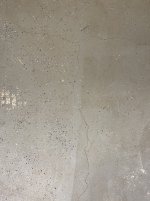Amidst all the fluff on this thread here is a flag waving against the wind. Just out of curiosity why are you recommending not to cut a control joint. You've done lots of building and I'm sure this is not a lightly made recommendation.
In my opinion and experience, the reason to cut the slab is to create a place for the concrete to crack right after the pour because of too much water used in the mix. When the crew working the mud can get away with it, they add water to make it easier for them to work it. The mix needs a certain amount of water, and everything extra will evaporate, which leaves a void in the slab, and that results in the large ugly cracks that nobody wants. Cutting the slab while it's still green allows the slab to move and give you a clean crack that is mostly hidden by the cut itself.
If the concrete can pass a slump test, the cracking is so minimal that it becomes hairline and difficult to see.
If there is rebar in the middle of the slab, those hairline cracks become almost impossible to see.
If there is wire in the middle of the slab, for all basic discussion, those cracks really don't exist. They are there, concrete always cracks, but you'll never find them.
Almost every slab poured with wire has the wire walked on and pushed to the bottom of the slab, so the cracks become more noticeable. Same thing with rebar that is not supported by chairs. The biggest lie in concrete is that they will pull it up while spreading the mud, and that it will stay there in the middle of the slab while everyone is walking on top of it.
The other reason for cutting a slab is because concrete gets bigger when it gets warm, and contracts when it gets cold. The best way to deal with this is to pour concrete in sections and have something between each section to absorb this movement. I've read that just having 30 pound tar paper between two pads will accomplish this, but most people use 1x4's or a product specially designed for this. If it's one big monolithic slab that will be changing temperature on a daily basis, then cutting the slab has the advantage of releasing the stress of it's movement and allowing it to break up at the cut and move with the temperature changes. This is also why concrete highways are so bad, because of all the expansion joints needed to keep the concrete from destroying itself during heating and cooling cycles.
Inside a residential house, where the temperature is controlled, nobody that I have ever met, and no house that I have ever been in, has the concrete cut regardless of how big the house is. The garage and porches are done separately because those areas will heat and cool differently then inside the house, which allows them to move on their own. Unfortunately, that's where I see a lot of cracking from excessive water. So maybe more contractors should cut the slab on residential work to hide their bad concrete work? I can see that happening if the guy in charge of the pour knows that he's pouring with too much water. I just don't allow that to happen, so cutting is never needed to hide that problem.
In this case, the rebar and wire are on chairs strong enough to walk on, so they should be in the middle of the pad.
He has PEX inside the pad to keep the temperature of the pad constant, so it won't expand and contract.
He poured the slab in two pieces, so the slab can expand and contract without damaging itself.
Considering all the time and effort that he put into planning this, and making it happen, I'm assuming that he didn't add a lot of water to the mix.
Because I believe all of this to be true, there is no reason to cut the slab.

